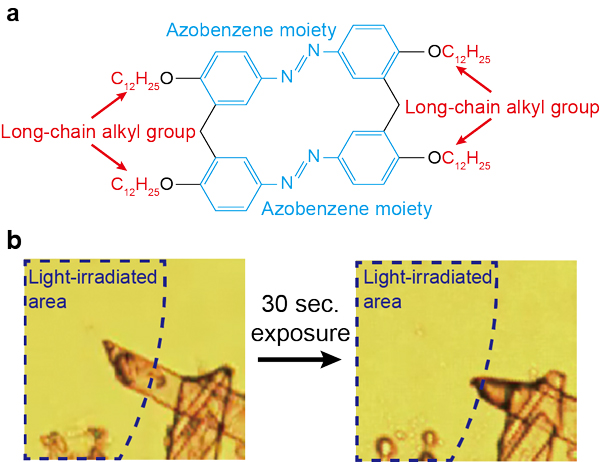Mechanism for Organic Crystal Melting Using Light Discovered
Mechanism for Organic Crystal Melting Using Light Discovered
Important point is coexistence of “alignment” and “motion” of molecules in crystals
Summary
A research group including Researcher Manabu Hoshino and Professor Shin-ya Koshihara, of the Department of Chemistry and Materials Science at Tokyo Institute of Technology, discovered a mechanism whereby organic crystals are melted by light irradiation through observation of crystal structure using synchrotron X-rays (1).
First they proved that 2 areas coexist in azobenzene (2) derivatives having long-chain alkyl groups: an “azobenzene-aligned” area and an “area of intense movement by long-chain alkyl groups within the crystal.“ Then they discovered that when this crystal was irradiated with UV light, the azobenzene caused a photoisomerization reaction (3), breaking the alignment, and that despite being inside a crystal, melting took place due to homogenization with the intensely moving long-chain alkyl group area. This crystal structure observation was achieved through high precision collection of X-ray diffraction data unobtainable in a laboratory system, through Single-crystal X-ray structure analysis (4) using synchrotron X-rays.
Heating to above room temperature is usually required to melt crystals, but by using technology that realizes crystal melting by way of a simple light-radiation method, the production costs for the molding/processing of organic materials can be drastically reduced. This research provides a molecular material design policy to industrialize light-irradiation melting technology.
The research was part of a collaboration with Chief Researcher Yasuo Norikane and Group Head Reiko Azumi, of the Electronics and Photonics Research Institute at the National Institute of Advanced Industrial Science and Technology (AIST), and Professor Shin-ichi Adachi, of the Photon Factory at the High Energy Accelerator Research Organization. The results of this research appeared in the online bulletin version of the American scientific journal “Journal of the American Chemical Society” on June 12th.
Explanation of Technical Terms
(1) |
Synchrotron X-rays : |
light emitted in the tangential direction when bunches (gatherings of plural electrons) revolving inside a circular accelerator referred to as a storage ring at a speed almost that of light are bent in a strong magnetic field. Markedly stronger X-rays are available compared to those from laboratory-system X-ray generators. Radiation of light with wavelength classified as X-ray are typically used, but vacuum ultraviolet and infrared synchrotron radiation are also used. |
(2) |
Azobenzene : |
an organic molecule in which two benzene rings are coupled via an azo group (the double bond between nitrogen atoms). Depending on the configuration of the two benzene rings with respect to the azo group, two kinds of structures exist: a cis structure (on the same side), and a trans structure (on opposite sides). |
(3) |
Photoisomerization reaction : |
a chemical reaction caused by irradiation of light in which a molecule changes the multiplicity or combination of its chemical bonds without the loss or gain of atoms (i.e., a chemical reaction accompanying with structural change only). Light-induced structural change is from cis structures to trans structures, or vice-versa. Trans structures are more thermally-stable, so cis structures are changed to trans structures by thermal process as well. |
(4) |
Single-crystal X-ray structure analysis : |
when a single crystal in which molecules are aligned regularly is irradiated with X-rays, a diffraction phenomenon that reflects the molecular structure and alignment (periodic structure) of the inside of the crystal occurs. The molecular and crystal structure (3-D array of the molecule) of the sample can be observed by recording somewhere between a few thousand and a few tens of thousands of these diffracted X-rays and analyzing them with a computer. |
Reference
Authors: |
Manabu Hoshino, Emi Uchida, Yasuo Norikane, Reiko Azumi, Shunsuke Nozawa, Ayana Tomita, Tokushi Sato, Shin-ichi Adachi, Shin-ya Koshihara |
Title: |
Crystal Melting by Light: X-ray Crystal Structure Analysis of an Azo Crystal Showing Photoinduced Crystal-Melt Transition |
Journal: |
Journal of the American Chemical Society |
DOI: |
|

Fig. 1 (a) Azobenzenes having a long-chain alkyl group targeted in the research.
(b) A micrograph observing the state in which crystal has been melted by ultraviolet irradiation.
. Any information published on this site will be valid in relation to Science Tokyo.



